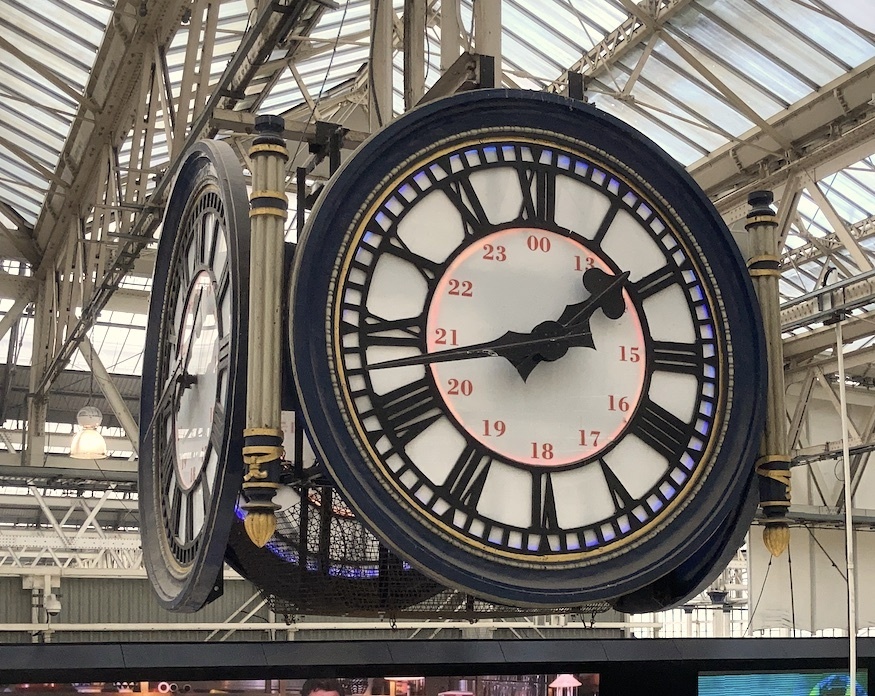For more of all things London history, sign up for our new (free) newsletter and community: Londonist: Time Machine.

For over a hundred years, the clock at Waterloo has been the meeting point for friends, family and lovers.
Have you ever met someone beneath the clock at Waterloo? It's one of those age-old London traditions that we've all heard about, even if we've never done it. But how old is the clock, and when did it become a famous meeting point?
Over a hundred years of timekeeping

According to Network Rail, who manage the station, the clock dates back "to the 1920s". But I think it's actually a tiny bit older. A press report from the Daily Mirror of 19 November 1919 describes the installation of the "two ton clock... of novel construction". The novelty lay in its mechanism, which included an electric "synchronome". This ensured all four clock faces were in synch with each other, and other clocks in the station.
There's another novelty too, though one you might not spot from over-familiarity. Look at the inner dial. It carries the numbers round to 23, allowing the time to be read in the 24-hour clock. Most of us use the system as second nature today, especially on the railways, but it was still a novelty back in 1919. It wouldn't be until 1964 that British Rail adopted 24-hour timekeeping as standard, but passengers at Waterloo had a preview decades before that.
The clock has been repaired and restored on a number of occasions. As can be seen from old photographs, its appearance has changed across the years, with the shape of the hands and the 24-hour dial coming and going. The most recent update came in 2010, when the clock was linked to GPS.
When did the clock become a famous meeting place?

Railway clocks have always served as prominent meeting points. A search of Victorian newspapers finds the phrase "meet me under the clock" as early as 1869. So it's likely that Waterloo's clock was an instant meet-up spot from its first appearance in 1919.
It soon became one of the most well-known rendezvous in London. As early as 1924, a short story in the syndicated press featured a meeting beneath the clock. Another in 1935, is entirely themed around a romantic liaison under the timepiece. Yet another from 1927 speaks of an "under the clock" tradition of meeting at Waterloo.
Love beneath the clock
For most people who meet under the Waterloo clock, it is merely a convenient spot that can be readily tracked down, even by those unfamiliar with the station. But for many, the location holds deep, personal memory. It's not hard to find press reports of lovers meeting by the clock; nor of first dates or proposals beneath this horological pendant. Below are just a handful of the comments I received on Twitter when asking for clock memories.

There must be thousands of couples out there who first locked eyes beneath the Waterloo clock. Perhaps some person reading this sentence owes their existence to a parental rendezvous within its purlieus. The Waterloo clock is London's true Eros; a chronometric cupid whose hands are arrow-shaped not by coincidence.
Famous liaisons
The clock has worked its magic in numerous acts of fiction, beyond the short stories mentioned above. Famously, Del Boy first met Raquel beneath the clock in the 1988 Only Fools and Horses Christmas special. Like so many other Waterloo couples, they would go on to become long-term partners.

And then, according to the Kinks' 1967 song Waterloo Sunset, "Terry meets Julie, Waterloo Station, every Friday night." We're not told where exactly they spot each other, but the famous clock is the obvious place, set back as it is from the "Millions of people swarming like flies 'round Waterloo underground".
For 100 years or more, the Waterloo clock has been London most romantic meeting place. But it's also so much more. It's the timepiece that launched a thousand day trips; the locus of reunions; a fixed point in time and space where those new to London, or to Britain, can seek a familiar face. What stories it could tell!



